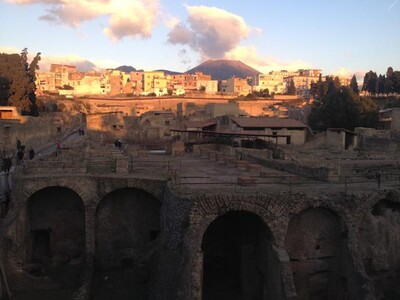
Naples
When we arrive from Rome, fireworks are being sold (and exploded) on street corners. We can’t tell whether this happens all the time or has do to with the season. We assume that the poor planning and construction here can be attributed to a feeling of futility – why invest in a landscape which may vanish beneath another pyroclastic flow from Vesuvius within the next century? The Italian government will give forty thousand euros to any family who will leave the area and relocate. A 2007 emergency plan intends to evacuate six hundred thousand people in 72 hours when the eruption of Vesuvius is immanent. Each of the eighteen municipalities of Naples is twinned with a region of Italy, who would shelter their people until the danger has passed and either they go home… unless they have no homes left to go to.
I had hoped that the Villa of the Papyri would be less closed than the official email I had received from the government had claimed it was, but I arrive to find that it’s entirely closed and not a part of the main site of the ancient Roman town, which is open. To reach it I would take a path from the far side of the site, which is now walled off. I stand at the wall and miserably admit to myself that I am as close as I can get to this library.
I am by the edge of the deep pit dug through the ash to reveal the Roman town, of Herculaneum. Immediately above the ruins the shattered peak of Vesuvius looms; a classic volcano shape. It’s very close. The floor of the pit is wet and filled with greenery. Looking to my right, I see a sequence of arches giving onto the former beach. I see my two children looking into them far below me. Each arch is full of skeletons, lying in contorted postures. They are the remains of the Romans who were killed instantly by gases at 400 degrees that rushed from the volcano.


